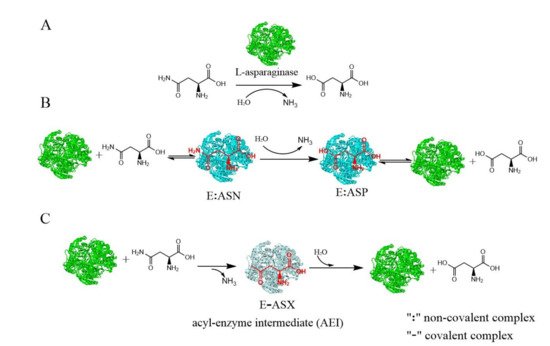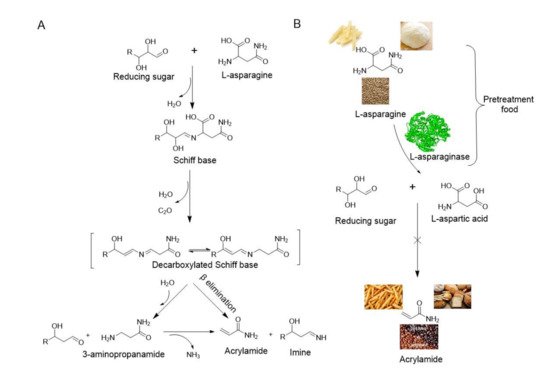L-asparaginase (E.C.3.5.1.1) hydrolyzes L-asparagine to L-aspartic acid and ammonia, which has been widely applied in the pharmaceutical and food industries. Microbes have advantages for L-asparaginase production, and there are several commercially available forms of L-asparaginase, all of which are derived from microbes. Generally, L-asparaginase has an optimum pH range of 5.0–9.0 and an optimum temperature of between 30 and 60 °C. However, the optimum temperature of L-asparaginase from hyperthermophilic archaea is considerable higher (between 85 and 100 °C). The native properties of the enzymes can be enhanced by using immobilization techniques. The stability and recyclability of immobilized enzymes makes them more suitable for food applications.
1. Introduction
L-asparaginase (L-asparagine amidohydrolase, E.C.3.5.1.1), which was first mentioned by Clementi in 1922, catalyzes the hydrolysis of L-asparagine into aspartic acid and ammonia (
Figure 1A)
[1][2][3]. L-asparaginases have wide distribution among microbes, plants, and animals. Microbes are preferred over other sources of production of L-asparaginase because they have some advantages, such as easy upstream bioprocessing and convenient downstream processing, both of which facilitate industry-scale production
[4]. Microbial L-asparaginase has been extensively studied in recent years for its potential applications in the pharmaceutical and food industries
[4][5].
Figure 1. A schematic diagram of the L-asparaginase reaction and its catalytic mechanisms: (A) A schematic diagram of the L-asparaginase reaction. (B) A schematic diagram of the direct displacement mechanism. (C) A schematic diagram of the double-displacement mechanism. Different colors stand for different conformations of the enzyme. (ASN, L-asparagine; ASP, aspartic acid).
L-asparaginase is a prime therapeutic agent for the treatment of acute lymphoblastic leukemia (ALL) and lymphosarcoma. Certain cancers, such as acute lymphoblastic leukemia (ALL), have little or no L-asparagine synthetase enzyme
[6]. As a result, L-asparagine in the blood becomes the sole source of this amino acid for ALL cells. Administration of L-asparaginase to ALL patients acts to deplete the blood of L-asparagine, which is non-essential for normal cells, depriving the ALL cells of this amino acid and ultimately leading to cell death. Elspar
®, Oncaspar
®, Erwinase
®, and Kidrolase
® are commercially available forms of L-asparaginase medicinal drugs from bacteria (
E. coli and
Erwinia chrysanthemi)
[7].
In 2002, researchers from Sweden discovered high contents of acrylamide in carbohydrate-rich foods subjected to elevated temperatures, highlighting the significant sources of dietary acrylamide intakes
[8][9]. Acrylamide is formed between reducing sugars such as glucose and L-asparagine due to frying, baking, or grilling starchy foods at over 120 °C in low humidity conditions through a non-enzymatic process called the Maillard reaction
[10][11][12][13]. The mechanism involves the formation of a Schiff base followed by the decarboxylation and elimination of either ammonia or a substituted imine under heat to yield acrylamide
[14] (
Figure 2A). Acrylamide has adverse effects on human health and has been proven to be neurotoxic, genotoxic, carcinogenic, and toxic to the reproductive system
[15][16]. The International Agency for Research on Cancer
[17] classified acrylamide as a probable human carcinogen (Group 2A), and the Scientific Committee on Food (SCF, 2002) reported that it was genotoxic
[16]. Consequently, the European Commission
[18] launched new reduction measures of acrylamide in food in 2017. Operators in the food business in Europe were obliged by Regulation 2158/2017 to reduce acrylamide content in their food products
[19].
Figure 2. Mechanism of acrylamide formation and acrylamide mitigation through L-asparaginase: (A) Acrylamide formed between reducing sugars and L-asparagine; (B) Acrylamide mitigation in foods through the conversion of L-asparagine to L-aspartic acid by L-asparaginase.
Acrylamide mitigation strategies were proposed, such as raw materials selection, product composition alteration, processing conditions optimization, and pretreatment procedures
[19]. Enzymatic treatment, which is a simple and effective way to reduce acrylamide in food without affecting the sensory or nutritional properties of the final product, has been proposed
[20]. L-asparaginase is a promising choice because of its hydrolytic activity toward L-asparagine into aspartic acid and ammonia in the treatment of foods. Consequently, aspartic acid cannot participate in the Maillard reaction, meaning acrylamide formation is significantly inhibited (
Figure 2B)
[21].
Acrylaway
® and PreventAse
® are commercially available forms of L-asparaginase from fungi (
Aspergillus oryzae and
Aspergillus niger)
[5][22], which are safe and are recommended for use as food additives by the FAO/WHO Expert committee
[22][23]. L-asparaginase has been granted “generally recognized as safe” (GRAS) status from the FDA
[16]. Furthermore, L-asparaginase is deactivated during the heating process, ensuring its safe application in the food industry
[24].
2. Application of Immobilized L-asparaginase in Food
Most studies of immobilized L-asparaginase have focused on its medical applications, while only a few works have been devoted to the food industry
[25]. The stability and reusability of L-asparaginase are both essential from an industrial point of view because of the enzymes subjected to incubation and pretreatment at elevated temperatures. The poor stability and non-recyclability of free L-asparaginase increase the cost of food processing and limit the large-scale usage of the enzyme. Many materials, such as chitosan, aluminum oxide pellets, magnetic nanoparticles, and agarose spheres, have been utilized to immobilize L-asparaginase in order to increase the stability and recyclability of L-asparaginase.
The native properties of the enzymes, such as thermal properties, activity, and substrate affinity, can be enhanced for food applications using immobilization techniques. Moreover, the unique reusability of an immobilized enzyme makes it more suitable for food applications. Alam et al. (2018) used magnetic nanoparticle-immobilized L-asparaginase to reduce acrylamide in a starch–asparagine food model. L-asparaginase from
Bacillus aryabhattai was immobilized on magnetic nanoparticles modified with aminopropyl triethoxysilane (APTES) using a cross-linking agent, glutaraldehyde. The immobilized enzyme showed more than a three-fold increase in thermal stability and retained 90% activity after the fifth cycle. The authors also found that the immobilized enzyme had a better affinity towards its substrate. The starch–asparagine food model of 2% (
w/v) L-asparagine and 2% starch (
w/v) (1:1) was treated with equal dose (18 U) of free or immobilized enzyme for 30 min and then heated at 180 °C for 5 min. The acrylamide formation in starch–asparagine food treated with free enzyme reduced by 60%, whereas no formation of acrylamide treated with immobilized enzyme was observed compared with the control
[26].
In another study, Ravi and Gurunathan (2018) used chitosan-immobilized L-asparaginase to reduce acrylamide in fried kochchi kesel. L-asparaginase from
Aspergillus terreus was covalently immobilized on chitosan by glutaraldehyde. Kochchi kesel banana slices were soaked in 5 U/mL of free or immobilized enzyme suspension at 60 °C for 20 min and then fried at 180 °C for 25 min. The mitigation of acrylamide in fried kochchi kesel with treatment by chitosan-immobilized L-asparaginase decreased by approximately 49% compared to treatment with the free enzyme
[27]. Immobilized L-asparaginase is more effective for acrylamide mitigation in food than the free enzyme because of its superior properties.
Immobilized L-asparaginase is utilized not only in batch processing but also in continuous production processes for fluidized food components for acrylamide mitigation. Li et al. (2020) used agarose sphere-immobilized L-asparaginase to reduce acrylamide in a fluid food model system. The immobilized L-asparaginase (Aga-ASNase) was obtained from an amidation reaction between L-asparaginase and food-grade agarose spheres activated with N-hydroxysuccinimide esters. The immobilized enzymes exhibited superior storage stability and reusability, with 93.21% and 72.25% of the initial activity retained after six consecutive cycles and storage for 28 days, respectively. The effluent flowing from the continuous catalytic process under optimal conditions (96 U, 35 °C, 1 mL/min) was heated at 180 °C in an oil bath for 10 min. Compared with the amount of acrylamide in the untreated system, the amount of acrylamide was reduced by almost 89% when the fluids flowed through the packed bed reactor, with an average residence time of 12 min
[28].


